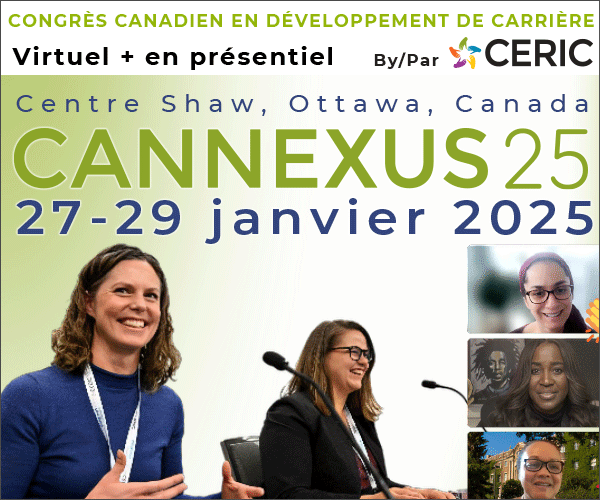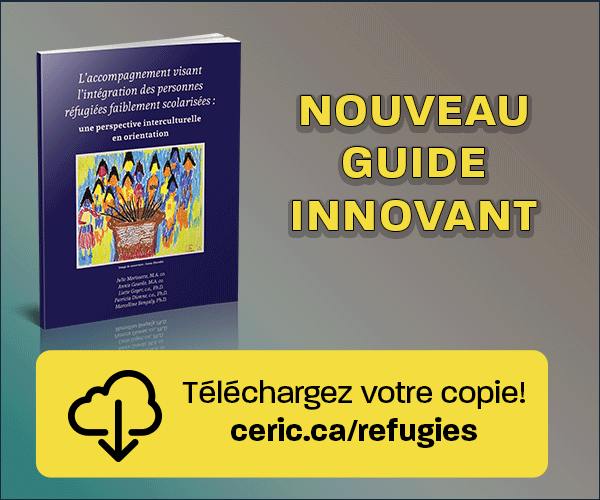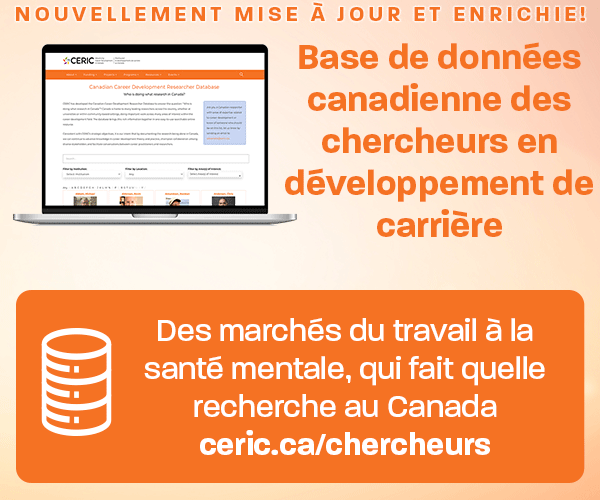La méthode narrative augmente la curiosité et l’exploration, le capital psychologique et la croissance personnelle pour en arriver à la lucidité professionnelle : une étude de résultat rétrospective
Mots-clés :
récit, étude, psychologie, carrièreRésumé
The paradigm in career counselling is shifting from traditional matching assessments to narrative methods. Storytelling approaches, life design principles, and evidence-based methods of practice are integrating theory into practical tools that career professionals want to use and can easily learn. Evidence of effectiveness of such methods are key to their being implemented, and broad career management variables beyond employment status need to be identified. The retrospective outcome study of one such method reported here explored variables of hope, optimism, resilience, self-efficacy, collectively
psychological capital, personal growth, and curiosity and exploration. Participants (N=68) were clients of a busy career management social enterprise. Analyses revealed statistically significant increases in all six career management variables, and identified key correlations with person-job fit, career clarity, and employment status. These results make a case for the continued adoption of narrative methods, and move this particular method into the realm of evidence-based practice.
Références
Adler, A. (1964). Individual Psychology of Alfred Adler. Harper Collins.
Arthur, N., & Collins, S. (2011). Infusing culture in career counselling. Journal of Employment Counseling, 48, 47-49.
Avey, J. B., Luthans, F., & Youssef, C. M. (2010). The additive value of positive psychological capital in predicting work attitudes and behaviors. Journal of Management, 36(2), 430-452.
Barrick, M. R., & Mount, M. K. (1991). The big five personality dimensions and job performance: a meta analysis. Personnel psychology, 44(1), 1-26.
Bennett, N., Lemoine,G.J. (2014). What VUCA Really Means for You. Harvard Business Review. Jan-Feb 2014.
Bezanson, L., O’Reilly, E., & Magnusson, K. (2009). Pan-Canadian mapping study of the career development sector.
Bloch, D. P. (2005). Complexity, chaos, and nonlinear dynamics: A new perspective on career development theory. The Career Development Quarterly,53(3), 194-207.
Braun, V., & Clarke, V. (2006). Using thematic analysis in psychology. Qualitative research in psychology, 3(2), 77-101.
Bridges, W. (1998). Creating You and Co. Da Capo Press.
Bright, J. E., & Pryor, R. G. (2005). The chaos theory of careers: A user’s guide. The Career Development Quarterly, 53(4), 291-305.
Brott, P. E. (2001). The storied approach: A postmodern perspective for career counseling. The Career Development Quarterly, 49(4), 304-313.
Cheung, F., Tang, C. S. K., & Tang, S. (2011). Psychological capital as a moderator between emotional labor, burnout, and job satisfaction among school teachers in China. International Journal of Stress management, 18(4), 348.
Cochran, L. (1997). Career counseling: A narrative approach. Sage.
Cole, K. D., Daly, A. E. & Mak, A. S. (2009). Good for the Soul: the relationship between work, wellbeing and psychological capital. The Journal of Socio-Economics, 38, 464-474
Csikszentmihalyi, M. (1992). Flow: The psychology of happiness. Rider.
Franklin, M. (2012). Methods in our madness! Benefits of a clear method-of-practice. Conference presentation. Cannexus12, Ottawa, Canada. Retrieved Oct.
, 2013 from http://www.cannexus.ca/CX/files/2012/handouts/CX12_P_Franklin_MethodsInOurMadness.pdf
Franklin, M. (2014). CareerCycles: A Holistic and Narrative Method of Practice. In B.C. Shepard, P. S.Mani (Eds.), Career Development Practice in Canada: Perspectives, Principles, and Professionalism (pp. a-b). Toronto: CERIC.
Franklin, M., Feller, R., & Yanar, B. (in press). Narrative Assessment Tools for Career and Life Clarification and Intentional Exploration: Lily’s Case Study. Career
Planning and Adult Development Journal
Fredrickson, B. L. (2001). The role of positive emotions in positive psychology: The broaden-and build theory of positive emotions. American psychologist, 56(3), 218.
Haidt, J. (2006). The happiness hypothesis: Finding modern truth in ancient wisdom. Basic Books
Hiebert, B., & Magnusson, K. (2014). The Power of Evidence: Demonstrating the Value of Career Development Services. In B.C. Shepard, P.S. Mani (Eds.), Career Development Practice in Canada: Perspectives, Principles, and Professionalism (pp. 489-530). Toronto: CERIC.
Hooley, T., Hutchinson, J., & Watts, A. G. (2011). Careering through the Web: the potential of Web 2.0 and 3.0 technologies for career development and career
support services. UKCES.
Judge, T. A., & Bono, J. E. (2001). Relationship of core self-evaluations traits—self-esteem, generalized self-efficacy, locus of control, and emotional stability—with job satisfaction and job performance: A meta-analysis. Journal of applied Psychology, 86(1), 80.
Kashdan, T. B., Gallagher, M. W., Silvia, P. J., Winterstein, B. P., Breen, W. E., Terhar, D., & Steger, M. F. (2009). The curiosity and exploration inventory-II: Development, factor structure, and psychometrics. Journal of research in personality, 43(6), 987-998.
Kashdan, T. B., Rose, P., & Fincham, F. D. (2004). Curiosity and exploration: Facilitating positive subjective experiences and personal growth opportunities. Journal of personality assessment, 82(3), 291-305.
Kashdan, T. B., Sherman, R. A., Yarbro, J., & Funder, D. C. (2013). How are curious people viewed and how do they behave in social situations? From the perspectives of self, friends, parents, and unacquainted observers. Journal of personality, 81(2), 142-154.
Kinicki, A. J., Prussia, G. E., & McKee Ryan, F. M. (2000). A panel study of coping with involuntary job loss. Academy of Management Journal, 43(1), 90- 100.
Krieshok, T. S., Black, M. D., & McKay, R. A. (2009). Career decision making: The limits of rationality and the abundance of non-conscious processes. Journal of Vocational Behavior, 75(3), 275-290.
Lam, T. C. & Bengo, P. (2003). A comparison of three retrospective self-reporting methods of measuring change in instructional practice. American Journal of Evaluation, 24(1), 65-80.
Lauver, K. J., & Kristof-Brown, A. (2001). Distinguishing between employees’ perceptions of person–job and person–organization fit. Journal of Vocational Behavior, 59(3), 454-470.
Lim, V. K., & Leng Loo, G. (2003). Effects of parental job insecurity and parenting behaviors on youth’s self-efficacy and work attitudes. Journal of Vocational Behavior, 63(1), 86-98.
Luthans, F., Avey, J. B., Avolio, B. J., Norman, S. M., & Combs, G. M. (2006). Psychological capital development: toward a micro intervention. Journal of Organizational Behavior, 27(3), 387-393.
Luthans, F., Avolio, B. J., Avey, J. B., & Norman, S. M. (2007). Positive psychological capital: Measurement and relationship with performance and satisfaction.
Personnel Psychology, 60(3), 541-572.
Luthans, F., & Youssef, C. M. (2007). Emerging positive organizational behavior. Journal of management, 33(3), 321-349.
Mitchell, K. E., Levin, S., & Krumboltz, J. D. (1999). Planned happenstance: Constructing unexpected career opportunities. Journal of counseling & Development, 77(2), 115-124.
National Steering Committee for Career Development Guidelines and Standards (2012). Canadian standards and guidelines for career development practitioners.
Retrieved from http://www.career-devguidelines.org/career_dev
Niles, S.G., Amundson, N.E. & Neault, R.A. (2011). Career flow: A hope-centered approach to career development. Columbus, Ohio: Pearson
Nimon, K., Zigarmi, D., & Allen, J. (2010). Measures of program effectiveness based on retrospective pretest data: Are all created equal?. American Journal of Evaluation
Nisbett, R. E. & Wilson, T. D. (1977). Telling more than we can know: Verbal reports on mental processes. Psychological Review, 84(3), 231-259.
Peavy, R. V. (1992). A constructivist model of training for career counselors. Journal of Career Development, 18(3), 215-228.
Pratt, C. C., McGuigan, W. M., & Katzev, A. R. (2000) Measuring program outcomes: Using retrospective pretest methodology. American Journal of Evaluation, 21(3). 341-349.
Rockwell, S. K., & Kohn, H. (1989). Post-then-pre evaluation. Journal of Extension, 27(2), 19-21. Rogers, C. R. (1951). Client-centered therapy: Its current practice,
implications and theory (p. 491). Boston: Houghton Mifflin.
Robitschek, C. (1998). Personal growth initiative: The construct and its measure. Measurement and Evaluation in Counseling and Development.
Robitschek, C., Ashton, M. W., Spering, C. C., Geiger, N., Byers, D., Schotts, G. C., & Thoen, M. A. (2012). Development and psychometric evaluation of the Personal Growth Initiative Scale–II. Journal of counseling psychology, 59(2), 274.
Savickas, M. L. (2012). Life design: A paradigm for career intervention in the 21st century. Journal of Counseling & Development, 90(1), 13-19.
Schmidt, F. L., & Hunter, J. E. (2000). Select on intelligence. Handbook of principles of organizational behavior, 3-14.
Stebleton, M. J. (2010). Narrative based career counseling perspectives in times of change: an analysis of strengths and limitations. Journal of Employment Counseling, 47(2), 64-78.
Snyder, C. R. (2002). Hope theory: Rainbows in the mind. Psychological Inquiry, 13(4), 249-275.
Snyder, C. R., Harris, C., Anderson, J. R., Holleran, S. A., Irving, L. M., Sigmon, S. T., et al. (1991). The will and the ways: development and validation of an individual-differences measure of hope. Journal of personality and social psychology, 60(4), 570.
Wanberg, C. R., Kanfer, R., & Banas, J. T. (2000). Predictors and outcomes of networking intensity among unemployed job seekers. Journal of Applied Psychology, 85(4), 491.
Wanberg, C. R., Kanfer, R., & Rotundo, M. (1999). Unemployed individuals: Motives, job-search competencies, and job-search constraints as predictors of job seeking and reemployment. Journal of Applied Psychology, 84(6), 897.
Werbel, J. D. (2000). Relationships among career exploration, job search intensity, and job search effectiveness in graduating college students. Journal of Vocational Behavior, 57(3), 379-394.
Zikic, J., & Franklin, M. (2010). Enriching careers and lives: introducing a positive, holistic, and narrative career counseling method that bridges theory and practice. Journal of employment counseling, 47(4), 180-189.
Zikic, J., & Klehe, U. C. (2006). Job loss as a blessing in disguise: The role of career exploration and career planning in predicting reemployment quality. Journal of Vocational Behavior, 69(3), 391-409.

Téléchargements
Publié-e
Comment citer
Numéro
Rubrique
Licence

Cette œuvre est sous licence Creative Commons Attribution - Pas d'Utilisation Commerciale - Pas de Modification 4.0 International.











